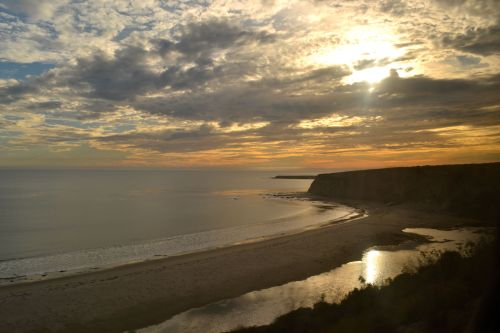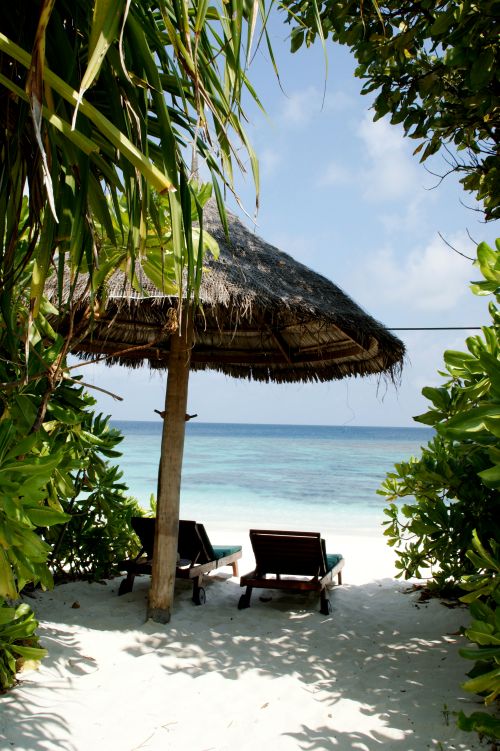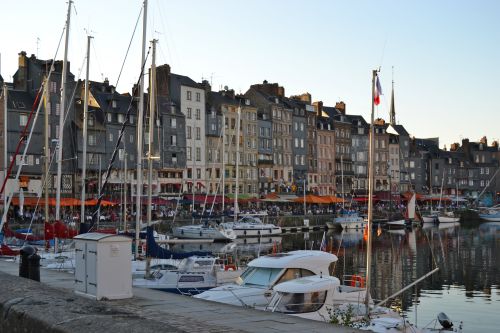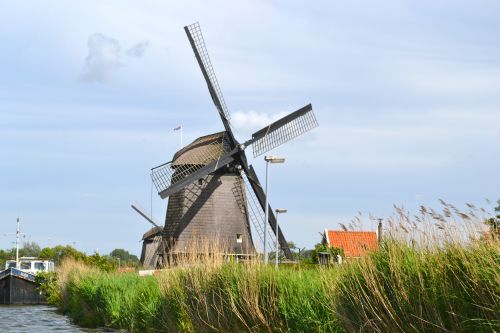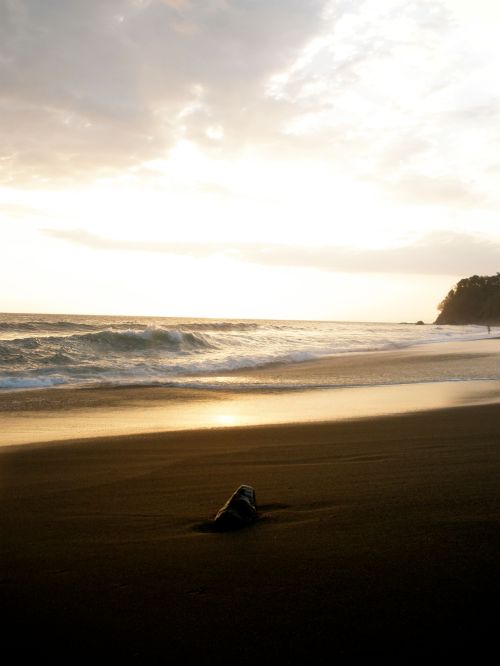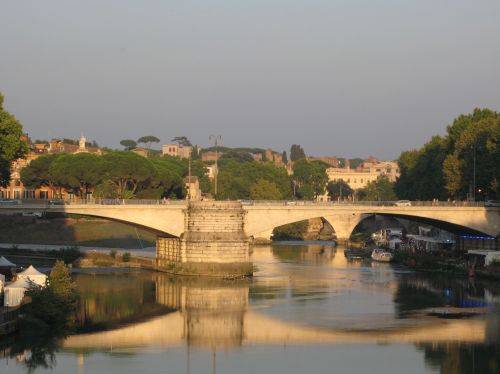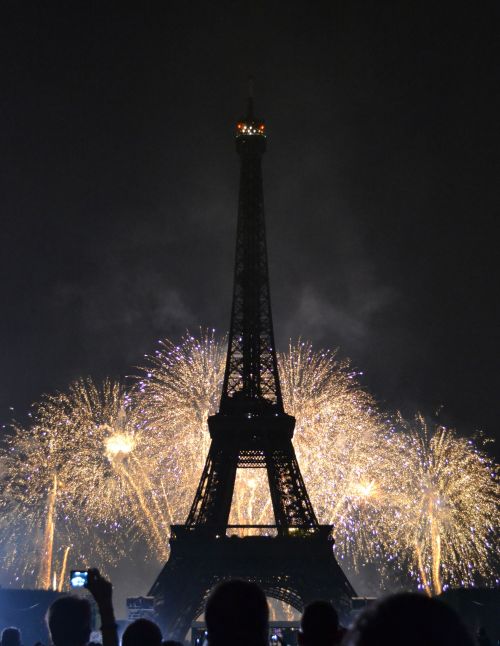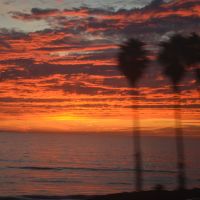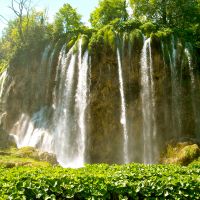 (Rose window)
(Rose window)
People seem genuinely surprised when I admit that I have yet to really miss Paris (the city, not the friends I left behind – I miss them all the time) after almost five months back in California. It is a pretty magical place, to be sure, but four years living abroad takes it’s toll, no matter how stunning your adopted country may have been. Lately, I have been thinking hard about my favorite moments, sites and adventures in Paris, as my knitting inter-friend Mere, will be traveling there this summer and has asked me for some ‘local’ tips. (Edifice of the Basilica St. Denis)
(Edifice of the Basilica St. Denis)
A few months before leaving, I compiled a list of all my ‘Last Call’ requests – events to attend, views to take in and sites to explore before departing. Although I could not get to all of them (I also was working at breakneck speed to try and wrap up several scientific projects), I made a reasonable dent in that ultimate wish list. Only one or two of these adventures were written up in the previous incarnation of this blog, Researching Paris. However, most of these outings have been left to languish, photo rolls unedited, recommendations and reflections unwritten. Until now. In the interest of spreading the word about some of the more unusual museums or historical landmarks of Paris that I was thrilled to have taken the time to visit, I am kicking off a series of ‘French Friday’ posts, dedicated to recapping those last months of touristing with one of my favorite monuments, the Basilica St. Denis.  (Reliquary “presumably” – and I quote – containing bits of Saint Denis himself)
(Reliquary “presumably” – and I quote – containing bits of Saint Denis himself)
First, let me admit that I can almost sense the collective “Wha???” going up over the internets as you all read that last sentence. Of the innumerable museums, squares and monuments in Paris (and it’s surroundings), am I really choosing the somewhat obscure Basilica Saint Denis as my favorite? Overwhelmingly, yes. Mainly because so few people visit or even know about it. I enjoyed my visit so thoroughly I have decided that I need to take the lead in spreading the word and motivating people to venture forth, on the slightly sketchy, aqua metro Line 13 out to the suburb of Saint Denis to visit the grandiose burial place of centuries of French kings.
 (Here lies Clovis I, king of France, 465-511 A.D.)
(Here lies Clovis I, king of France, 465-511 A.D.)
The land on which the Basilica was built has been one of religious significance for centuries, as far back as Roman times when it was the site of a local cemetery. The role it was to play in the history of France, however, was cemented by the Christian legend, which states that after Saint Denis (the patron saint of France) was martyred by decapitation on the hill of Montmartre, the headless body remained alive, scooped up the now detached head and walked two miles to the outskirts of town and dropped dead on this site, indicating where he was to be buried and that a cathedral be erected in his memory. Artistic renderings of this event were scattered throughout the church and crypts, bringing a macabre humor to the very solemn surroundings (because paintings of a corpse spewing blood from his neck while carrying his own head are so over-the-top in many cases as to be humorous). 

 (Excavations of the ancient Roman temple and, supposedly, the tomb of St. Denis, with the projected image of where he must have rested to spur one’s imagination)
(Excavations of the ancient Roman temple and, supposedly, the tomb of St. Denis, with the projected image of where he must have rested to spur one’s imagination)
The first Christian church was built here in the late 5th century, led by St. Genevieve (who also wrote the first accounts of St. Denis’ martyrdom), but it was the 7th century king of the Franks, Dagobert, who built the first grand cathedral here, complete with a shrine for Saint Denis’ remains. As with many other grand European cathedrals, each wing dates from a different century and is built in slightly different styles to reflect the era. Overall, the church is considered to be the first major cathedral to be built in the Gothic style (in which the more famous Notre Dame Cathedral in Paris is also built). Beginning in the 10th century, all but only a few of the French monarchs were buried here, including some of the most famous kings and queens: François I (the French counterpart to England’s Henry VIII and patron to Leonardo de Vinci), Henri II and Catherine de Medicis (who had several statues – a bit confusing), as well as King Louis XVI and his wife, Marie Antoinette. This is no simple cemetery, however, each crypt is topped with a marble effigy of the monarch in question, giving the viewer a real sense of the personality, size and glowering stare of the once living person contained within.
Beginning in the 10th century, all but only a few of the French monarchs were buried here, including some of the most famous kings and queens: François I (the French counterpart to England’s Henry VIII and patron to Leonardo de Vinci), Henri II and Catherine de Medicis (who had several statues – a bit confusing), as well as King Louis XVI and his wife, Marie Antoinette. This is no simple cemetery, however, each crypt is topped with a marble effigy of the monarch in question, giving the viewer a real sense of the personality, size and glowering stare of the once living person contained within. (A very busty Marie Antoinette and devout Louis XVI, who were actually interred downstairs in the crypt)
(A very busty Marie Antoinette and devout Louis XVI, who were actually interred downstairs in the crypt)
I just could not get enough of this place. Take this with the rather large grain of salt that I do have a degree in medieval history and that I spent much of my undergraduate years being more entertained by French epics than actually having much to do on Saturday nights. Not only were almost all the kings and queens of France from the 10th-18th centuries put to rest here, but these regencies put great effort into locating, exhuming and transporting even earlier monarchs to their final, final resting places among them in this space. The oldest set of kingly remains that I found belonged to Clovis I, king of France from 465-511 (about whom much was written in the aforementioned epics). They also stored several well-preserved examples of royal vestments, including the coronation cape and crowns from Louis XVI and Marie Antoinette, as well as Charlemagne’s sword and armor (!!). (Coronation garb for Louis and Marie, my reflection on the left for scale)
(Coronation garb for Louis and Marie, my reflection on the left for scale)
The architecture of the cathedral itself was very similar to Notre Dame – soaring, vaulted ceilings, rose windows and a sense of expansive space – but also a bit more rickety and drafty, which is understandable seeing that the latter is in the center of the city and welcoming thousands of visitors (and donations) daily. The pews were arranged in the center nave and the Basilica is a working church, welcoming believers for routine weekly services. What were not at all ‘normal’ were the hundreds of small crypts and statuary surrounding a place of modern worship. As mentioned previously, each topped with an extremely lifelike mask of the wearer in life, most clasping their hands in devout prayer (no matter whether that was lifelike at all). (Claude, queen of France during the reign of François I, not very demure in repose)
(Claude, queen of France during the reign of François I, not very demure in repose) (Henri II, king and husband to Catherine de Medicis, looking quite in pain)
(Henri II, king and husband to Catherine de Medicis, looking quite in pain) Beneath the church we visited the crypts, which included the Bourbon family plot (Louis XVI and Marie Antoinette are here), several renderings of Saint Denis and his head, as well as an ossuary. After visiting the Catacombs (another must see!), this collection of remains was not initially shocking, however when I read that one of the urns contains the heart of Louis XVII, the little king who died under house arrest following the execution of his parents (Louis and Marie) during the French Revolution, I was entranced. Conspiracy theories about his mistreatment during captivity, death from chronic illness at age 10 (or possible escape) and, perhaps, a living, lost royal bloodline of France haunted the Republic for years until, in the year 2000, genetic tests performed on the preserved tissue stored at the Basilica finally confirmed, without a doubt, that it was the boy king. Every corner and shadow in this edifice had a story to tell.
Beneath the church we visited the crypts, which included the Bourbon family plot (Louis XVI and Marie Antoinette are here), several renderings of Saint Denis and his head, as well as an ossuary. After visiting the Catacombs (another must see!), this collection of remains was not initially shocking, however when I read that one of the urns contains the heart of Louis XVII, the little king who died under house arrest following the execution of his parents (Louis and Marie) during the French Revolution, I was entranced. Conspiracy theories about his mistreatment during captivity, death from chronic illness at age 10 (or possible escape) and, perhaps, a living, lost royal bloodline of France haunted the Republic for years until, in the year 2000, genetic tests performed on the preserved tissue stored at the Basilica finally confirmed, without a doubt, that it was the boy king. Every corner and shadow in this edifice had a story to tell. (His was not the only heart – coeur – stored in the urns below)
(His was not the only heart – coeur – stored in the urns below) Occasionally a small tour group would rush by and the guides, speaking in rapid-fire French would rattle off names and bloodlines while the visitors would nod respectfully. I felt like I had stumbled across an undiscovered treasure – to be in that cathedral, surrounded by millennia of history and only a few locals with whom I had to share the space and experience was magical, like I had found a way to reach across time. I sat for a moment in the absolute silence and tried to imagine an abandoned Westminster Abbey, an empty Père Lachaise, or any other famous resting place of leaders and great men where I could find this extent of silence and peace and promptly drew a blank. The atmosphere was even tinged with a bit of sadness as if, after thousands of years, these leaders (not all good, mind you – I am very aware of that), had been left in a dark, dank corner of Paris and forgotten.
Occasionally a small tour group would rush by and the guides, speaking in rapid-fire French would rattle off names and bloodlines while the visitors would nod respectfully. I felt like I had stumbled across an undiscovered treasure – to be in that cathedral, surrounded by millennia of history and only a few locals with whom I had to share the space and experience was magical, like I had found a way to reach across time. I sat for a moment in the absolute silence and tried to imagine an abandoned Westminster Abbey, an empty Père Lachaise, or any other famous resting place of leaders and great men where I could find this extent of silence and peace and promptly drew a blank. The atmosphere was even tinged with a bit of sadness as if, after thousands of years, these leaders (not all good, mind you – I am very aware of that), had been left in a dark, dank corner of Paris and forgotten. Maybe that is the point. Saint Denis – the suburb, not the saint or Basilica – is a somewhat edgy arrondissement to the north of Paris proper, more infamous for its criminal activity and immigrant population than for its unquestionable historical significance. I found that, by day at least, tourists have little to fear (with your purses well zipped and common sense on high as should be done anywhere in the city) and any negative reputation of the region should not dissuade a motivated history lover from taking in one of the most overlooked, yet compelling monuments Paris has to offer.
Maybe that is the point. Saint Denis – the suburb, not the saint or Basilica – is a somewhat edgy arrondissement to the north of Paris proper, more infamous for its criminal activity and immigrant population than for its unquestionable historical significance. I found that, by day at least, tourists have little to fear (with your purses well zipped and common sense on high as should be done anywhere in the city) and any negative reputation of the region should not dissuade a motivated history lover from taking in one of the most overlooked, yet compelling monuments Paris has to offer.


 (Racing by a show-stopping Santa Barbara sunset on the Amtrak Coast Starlight)
(Racing by a show-stopping Santa Barbara sunset on the Amtrak Coast Starlight) (Dolphins playing alongside our whale watching trip in San Diego)
(Dolphins playing alongside our whale watching trip in San Diego) (Young rhesus macaques playing with prayer flags – and visitors – at Swayambhunath – The Monkey Temple – in Kathmandu, Nepal)
(Young rhesus macaques playing with prayer flags – and visitors – at Swayambhunath – The Monkey Temple – in Kathmandu, Nepal) (Watching the last wave of the evening, and resting after a long day in the sun and sea – Playa Dominica, Costa Rica)
(Watching the last wave of the evening, and resting after a long day in the sun and sea – Playa Dominica, Costa Rica) (The Peloton entering Place de Concorde in the final stage of the Tour de France – Paris, France)
(The Peloton entering Place de Concorde in the final stage of the Tour de France – Paris, France)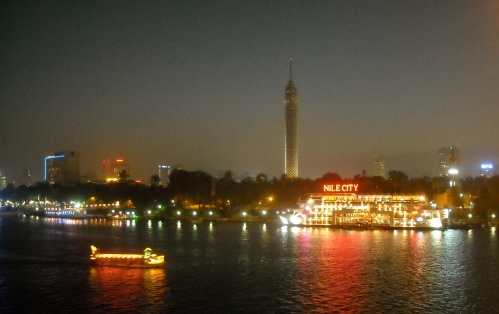 (The slow meander of The Nile on a clear night – Cairo, Egypt)
(The slow meander of The Nile on a clear night – Cairo, Egypt) (And, of course, no “Motion” post would be complete in my world without featuring my niece and nephew (both newly) in motion – thrilled with their mobility and clearly on a mission to tackle my camera.)
(And, of course, no “Motion” post would be complete in my world without featuring my niece and nephew (both newly) in motion – thrilled with their mobility and clearly on a mission to tackle my camera.)

